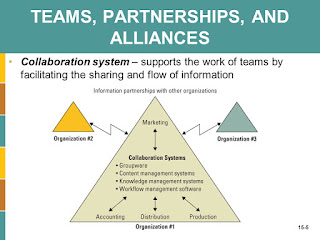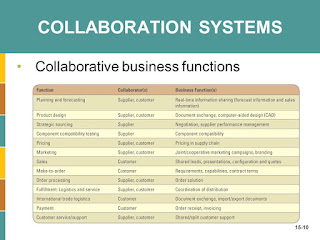TEAM,PARTNERSHIP AND ALLIANCES
- Organizations create and use teams, partnership and alliances to:
→Undertake new initiatives
→Address both minor and major problems
→ Capitalize on significant opportunities
- Organizations create teams, partnerships, and alliances both internally with employees and externally with other organizations
- Collaboration systems- supports the work of teams by facilitating the sharing and flow of information

- Organizations from alliances and partnership with other organizations based on their core competency
→Core competency strategy-organization chooses to focus specifically on its core competency and forms partnerships with other organizations to handle non-strategic business processes
- Information technology can make a business partnership easier to establish and manage
⇉The internet has dramatically increased the ease and availability for IT-enabled organizational alliances and partnership
COLLABORATION SYSTEMS
- Collaboration solves specific business tasks such as telecommuting, online meetings, deploying applications and remote project and sales management
- Collaboration system-an IT based set of tools that supports the work of teams by facilitating the sharing and flow of information
- Two categories of collaboration:
↳Structured collaboration (process collaboration)- involves shared participation in business processes such as workflow in which knowledge is hardcoded as rules

- Collaboration system include:
→content management systems
→workflow management systems
→Groupware systems
KNOWLEDGE MANAGEMENT SYSTEMS
- Knowledge management(KM) -involves capturing, classifying, evaluating, retrieving and sharing information assets in a way that provides context for effective decision and actions
- Knowledge management system-supports the capturing and use of an organization's "know-how"
EXPLICIT AND TACIT KNOWLEDGE
- Intellectual and knowledge based assets fall into two categories:
⧭Tacit knowledge- knowledge contained in people's heads
- The following are two best practices for transferring or recreating tacit knowledge
🔺Joint problem solving - a novice and expect work together on a project.
Shadowing – less experienced staff observe more experienced staff to learn how their more experienced counterparts approach their work
· Joint problem solving – a novice and expert work together on a project
Ø Reasons why organizations launch knowledge management programs
Ø KM Technologies
Ø Knowledge management systems include:
· Knowledge repositories (databases)
· Expertise tools
· E-learning applications
· Discussion and chat technologies
· Search and data mining tools
Ø KM and Social Networking
Ø Finding out how information flows through an organization
 |
| Social Networking |
· Social networking analysis (SNA) – a process of mapping a group’s contacts (whether personal or professional) to identify who knows whom and who works with whom
· SNA provides a clear picture of how employees and divisions work together and can help identify key experts
· Social Networking
Ø Content Management
Ø Content management system (CMS) – provides tools to manage the creation, storage, editing, and publication of information in a collaborative environment
Ø CMS marketplace includes:
· Document management system (DMS)
· Digital asset management system (DAM)
· Web content management system (WCM)
Document management system (DMS)
Ø Supports the electronic capturing, storage, distribution, archival, and accessing of documents
Digital asset management system (DAM)
Ø Similar to DMS, generally works with binary rather than text files, such as multimedia files types.
Web content management system (WCM)
Ø Adds an additional layer to document and digital asset management that enables publishing content both to intranets and to public Web sites
Ø Content management system vendor overview
WORKING WIKIS
Ø Wikis - Web-based tools that make it easy for users to add, remove, and change online content
Ø Business wikis - collaborative Web pages that allow users to edit documents, share ideas, or monitor the status of a project
Ø Business wikis
Ø Workflow Management Systems
Ø Work activities can be performed in series or in parallel that involves people and automated computer systems
Ø Workflow – defines all the steps or business rules, from beginning to end, required for a business process
Ø Workflow management system – facilitates the automation and management of business processes and controls the movement of work through the business process
Ø Messaging-based workflow system – sends work assignments through an e-mail system
Ø Database-based workflow system – stores documents in a central location and automatically asks the team members to access the document when it is their turn to edit the document
Ø Groupware Systems
Ø Groupware technologies
Ø Groupware – software that supports team interaction and dynamics including calendaring, scheduling, and videoconferencing
VIDEOCONFERENCING
Ø Videoconference - a set of interactive telecommunication technologies that allow two or more locations to interact via two-way video and audio transmissions simultaneously.
WEB CONFERENCING
Ø Web conferencing - blends audio, video, and document-sharing technologies to create virtual meeting rooms where people “gather” at a password-protected Web site.
INSTANT MESSAGING
Ø E-mail is the dominant form of collaboration application, but real-time collaboration tools like instant messaging are creating a new communication dynamic
Ø Instant messaging - type of communications service that enables someone to create a kind of private chat room with another individual to communicate in real-time over the Internet
Ø Instant messaging application



























